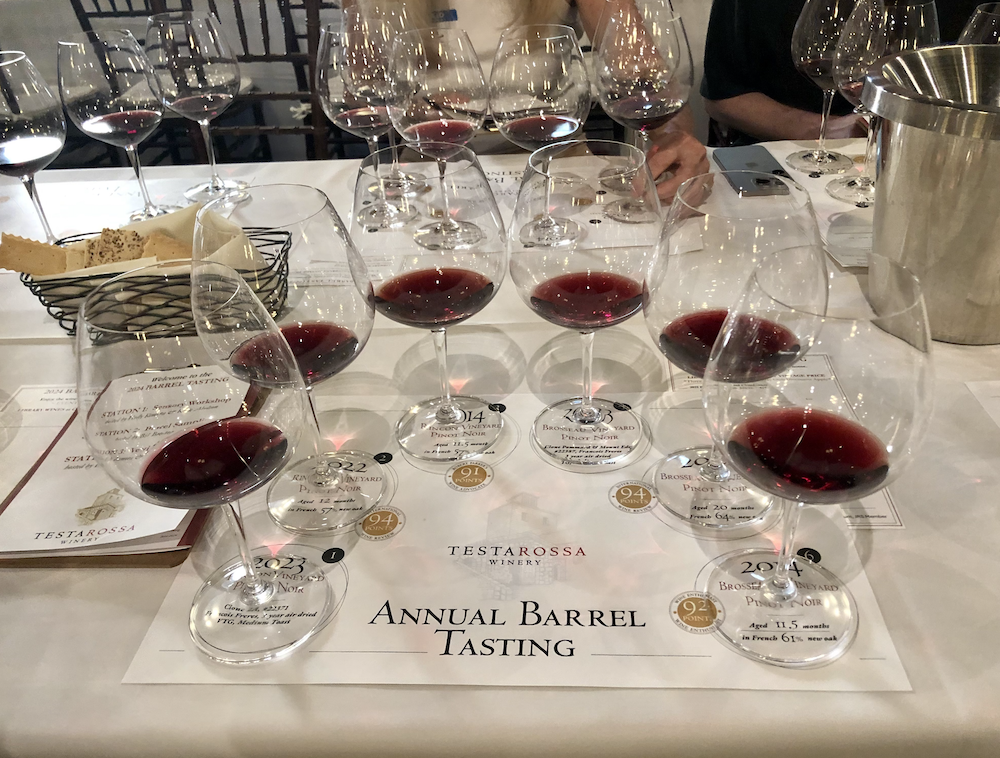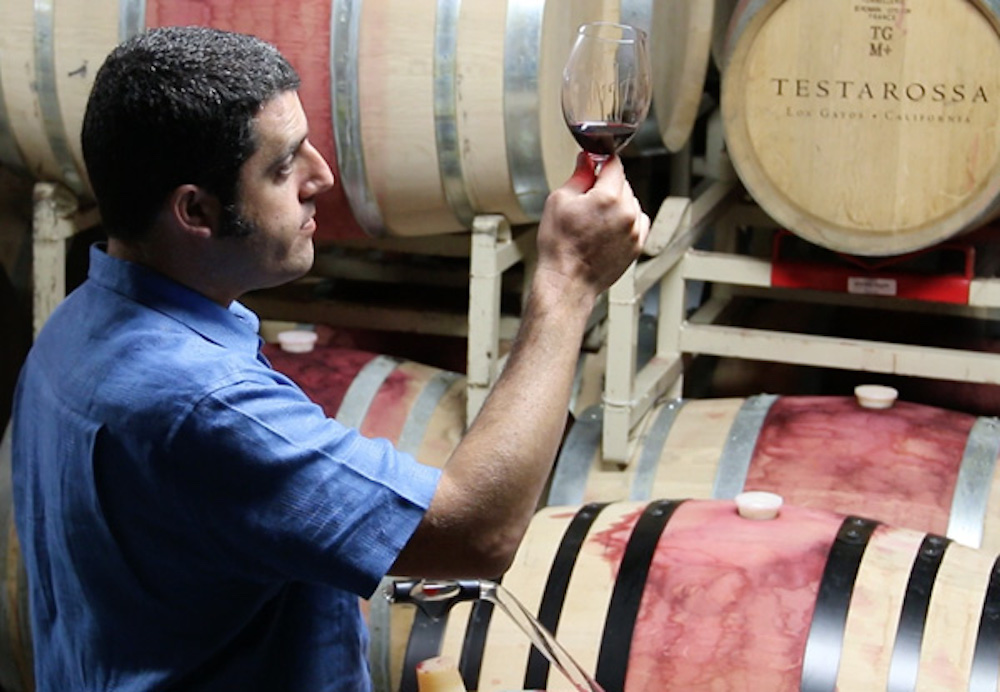
July 19, 2024 – When you’ve been working with the same set of vineyards for over 20 years, you become well versed in what they need to elevate them to the pinnacle of their performance, year after year. It’s like a Formula 1 or IndyCar team boss knowing what their car needs for each track, in different conditions. Reading the impact of weather is job number one in both winemaking and auto racing.
Barrel choice is critically important when it comes to making the best wines, and Testarossa’s winemaker Bill Brosseau has become an expert on barrels. He’s honed in on specific coopers and forest sources over time, as he’s sought what works best for each vineyard.
At the same time, he makes tweaks every year, as cooperages come up with different options, like new ways of toasting wood. Overall, he’s gone to barrels with longer air-drying over time, as the subtleties of wood integration are very much impacted by seasoning and toast levels. He can still leave the wine in barrel for a solid year or more and not be too concerned about the wine sopping up too much woodiness. Of course, this varies by vineyard and clone, and by vintage.
When 10 curious winetasters and I ventured into the Testarossa cellar for the annual barrel tasting event last weekend, we didn’t know what to expect, because Brosseau is famous for always presenting a new morsel of information to chew on.
It’s a constant reminder that excellent winemaking is 90% getting the grapes right, 9% getting the barrels right and 1% divine inspiration. Oh, and 100% luck when it comes to Mother Nature’s part in the unscripted play that is agriculture.
From the first barrel sample, Brosseau challenged us to identify the vineyard or the clone of Pinot Noir in our glasses. There was no way any of us could have guessed it was a new clone of Pinot Noir, 122, which had been sourced from a high-end chateau in the most exclusive part of Burgundy.

This clonal material is now growing at the Fogstone Vineyard at the northern end of the Santa Lucia Highlands (SLH), and we were among the first outside of the Testarossa cellar crew to sample it. My impression was that it was earthy, with a nice truffle undertone, and there was a spicy, almost peppery edge that leaned towards clove. I could see it adding a lot to a vineyard blend.
Brosseau next reminded us that vintage 2023 was long and cool, with great hangtime and no heat spikes, unlike 2022, when a Labor Day heat wave caused some to pick too soon, and others, too late.
He also reminded us of the fire and brimstone harvest of 2020, during which Testarossa lost most of their contracted fruit in the Santa Lucia Highlands to smoke taint. This lesson underscored that diversity of sources is utterly critical for a large operation like Testarossa with a big wine club to support.
Fittingly, this was a backdrop to the next sample, which was Pommard 4 from the La Rinconada Vineyard in the Sta Rita Hills, a Santa Barbara County region that was not impacted by that freak lightning storm that ruined harvest for so many in Monterey, Santa Cruz, Livermore, Sonoma and Napa.
From a new barrel, the wine presented aromas of cherry and earth, along with mouthcoating palate that exhibited both a green herbal streak (I thought it was tarragon) and distinctive coffee on the finish—a hallmark of a new barrel with a bit of heavier toast.
With the third sample, Brosseau was excited to introduce us to a new method of toasting barrels. The sample of clone 777 Pinot Noir from Fogstone Vineyard in the SLH, was taken from a barrel lightly toasted using hot porcelain tile, instead of the direct flame that coopers usually employ. Brosseau said that this essentially smokeless way of toasting a barrel gave him an option for potentially mitigating the impacts of smoke on the fruit, should that circumstance arise again.
Compared with the fourth sample of Fogstone clone 777 Pinot Noir done in a traditionally toasted barrel, we noticed more depth and noticeable char: definitely more toasty wood presence.
The final lesson involved a comparison of three different sizes of barrels: traditional Burgundy (228L), puncheon (475L) and a hogshead (300L). All were filled with clone 777, from the Tondre Vineyard in the Santa Lucia Highlands (SLH). The wine from the first and smallest barrel was the most concentrated, with candied strawberry, bright lemon, orange rind and intense acid: everything about it had sharp elbows.
As we tried the subsequently larger barrel sizes, we found the wine more aired out, relaxed, matured and approachable. It was like time had accelerated the aging process, just a little bit, but with a softer, gentler touch.
We next had the chance to try samples of vintages 2023, 2022/2021 and 2014, from both the Brosseau Vineyard in the Chalone AVA and Rincon Vineyard in the Arroyo Grande AVA. This was particularly exciting, not only to realize the brightness, energy and inherent power of the long, cool 2023 vintage, which promises incredible longevity, but to appreciate the approachability and immediate drinkability of the 2022s.
The 2023 Rincon sample was clone 2A, from a 74-acre vineyard planted by the Talley family in the 1970s. It was minerally, with great acid, showing strawberry, cranberry, along with meaty pastrami, nutmeg and tobacco, ending with a lovely hint of saltwater taffy. Truly a fascinating wine. The 2022 Rincon is totally delicious right now, and is a dead ringer for cherry pie with cinnamon.
The warm weather of 2022 really accelerated ripening and quite frankly, yields wines that are very fruity and fleshy in the near term, but they are somewhat lacking in acidity, and will not be the best long-term agers.
Known for its sandy soils and warm, parched climate, Chalone delivers wines of textural superiority, and this was evident in all three of the Brosseau examples. The 2023 sample was a blend of Pommard and Mount Eden, done in François Frère barrels, exhibiting lots of fun and sass, with a mouthfilling texture that is light but expressive, oozing pure cranberry. The word I kept coming back to was pristine.
The 2021 Brosseau is super smooth, with dark cherry and a sandy silky texture, with big tannins. It has many miles to go before it sits down for a rest.
The 2014s from both vineyards were wonderfully developed, showing many layers of complexity, from the dark fig and root beer of the Rincon, and the wonderfully deep, plummy and spicy personality of the Brosseau. The texture is just phenomenal. We all paused to take in and appreciate the extraordinary smooth and seamless delivery of this superb wine. Heads nodded in unison, with expressions a mix of astonishment and delight.
This is what you want a 10-year-old wine to do: surprise, excite and thrill. Fortunately, there are still bottles left of both these 2014 gems. You can’t buy time, and you can’t relive the past, but a bottle of wine like this can make you feel that somehow, you just did.
About the author
Laura Ness is a longtime wine journalist, columnist and judge who contributes regularly to Edible Monterey Bay, Spirited, WineOh.Tv, Los Gatos Magazine and Wine Industry Network, and a variety of consumer publications. Her passion is telling stories about the intriguing characters who inhabit the fascinating world of wine and food.
- Laura Nesshttps://www.ediblemontereybay.com/author/lness/
- Laura Nesshttps://www.ediblemontereybay.com/author/lness/
- Laura Nesshttps://www.ediblemontereybay.com/author/lness/
- Laura Nesshttps://www.ediblemontereybay.com/author/lness/


